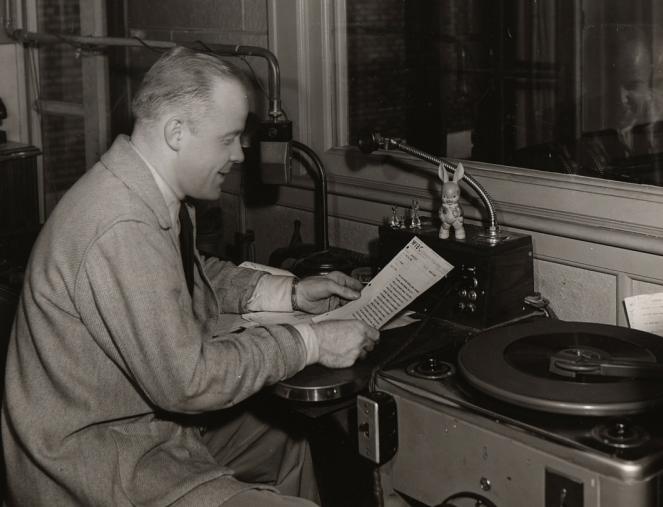Fairbanks Communications began when the Fairbanks family sold the to in 1948. , grandson of Vice President , negotiated the merger with the , which ended family ownership that dated to 1892 when Charles Warren Fairbanks and William Henry Smith (Richard Fairbanks’ great uncle) had purchased the paper. In addition to the city’s afternoon newspaper, the family also owned radio station .

Afternoon papers were failing across the country. While WIBC brought in revenue, the newspaper struggled financially following World War II. According to Federal Communications Commission (FCC) rules that were in place at the time, no single entity could own licenses for two radio stations operating in the same market. Pulliam already owned . WIBC, therefore, had to be spun off before Pulliam could take over the . Fairbanks used money from a family trust to purchase the WIBC license and set up a new company, WIBC, Inc., the forerunner of Fairbanks Communications. Creating WIBC, Inc. was the beginning of what would become a broadcasting empire.
The initial primary stockholders of WIBC, Inc. included Fairbanks and other family members. Fairbanks already served as the station’s president and general manager. In 1948, WIBC operated at 5,000 kilowatts day and night. Soon after creating WIBC, Inc., Fairbanks increased its power to 50,000 kilowatts during daytime hours, which expanded the station’s reach to cover Indiana, Illinois, and Kentucky. Reportedly, the station could be heard as far away as Florida, Georgia, Alabama, and Mississippi.
The station offered a variety of programming in these early years. Because of Fairbanks’ newspaper background, WIBC also began to focus news broadcasting. Fairbanks realized that his employees at the station “knew the radio business but didn’t know the news” and, therefore, hired personnel to create a newsroom for the station. Early on-air personalities included Jim Morrow, , Easy Gwynn, Mike Dunn, and Bill Fox. Other key hires were Lou Palmer and news director . In 1952, Fairbanks collaborated with and general manager to form the .
In 1957, Fairbanks entered the broadcasting market in Central Florida, with the purchase WRMF in the Cape Canaveral area. The station entertained NASA personnel and their families for the next two decades. At a time when most people had only AM receivers, Fairbanks applied for an FM-radio license. In December 1960, WIBC-FM began broadcasting in an automated classical format. Fairbanks also sought a foothold in the television market. During the 1950s, WIBC, Inc. competed unsuccessfully for the license for Channel 13 in Indianapolis (see ). Fairbanks, instead, purchased Atlanta station WAII-TV in 1962.

By 1968, Fairbanks wanted to take complete control of WIBC, Inc. He sold WAII-TV, which at the time was its most lucrative asset, and used the proceeds to buy out the monetary interests of other family members in the company. Fairbanks became sole owner in August 1968, and the company name changed officially to Fairbanks Broadcasting.
Fairbanks lured James Hilliard, who previously had been a morning WIBC on-air personality, to Indianapolis from Philadelphia in 1968 to be WIBC’s general manager and made him part owner of the company. Hilliard relaunched WIBC-FM as the counterculture rock-and-roll station , a direct competitor to the dominant station that had begun broadcasting in 1963. At the same time, WIBC-AM became the “go-to” station for news. WIBC-AM and WNAP-FM captured both adult and adolescent markets in Indianapolis and drew half of all advertising dollars spent in the city on radio to Fairbanks.
At its peak, Fairbanks Broadcasting owned 20 radio stations. These included KVIL in Highland Park-Dallas; WIBG, in Philadelphia; and sister stations KCMO-AM and KCEZ-FM in Kansas City. Fairbanks also purchased WJNO AM and FM in West Palm, Beach, Florida, which led the company to dominate the radio market in the most populous region of South Florida. In addition to the sister stations in West Palm Beach and WRMF, Fairbanks owned two AMs and one FM station in Fort Pierce and another in Palm Beach.
In 1981, Fairbanks gave the WIBC building, located at 2835 N. Illinois Street, to for its student-run station , and the company headquarters moved to 9333 N. Meridian Street. Two years later, in 1983, Fairbanks began divesting. KVIL and WIBC/WNAP sold to John Blair & Company. Blair acquired the Texas station for $35 million and the flagship Indianapolis stations for about $50 million. The company headquarters moved to West Palm, Beach, Florida, in 1983, and its name changed to Fairbanks Communications.
In the early 1980s, Fairbanks diversified into cable television in Dearborn County in Indiana and in Delray Beach, Gulf Stream, and Palm Beach County, in Florida. With the move to Florida, the company also established a charter airplane division, called Fairwind Aviation. Understanding that cable television eventually would fall into the hands of just a few companies, Fairbanks divested of the cable television holdings, selling to Adelphia Communications Corporation in 1995. Fairbanks came to a similar decision about the radio stations that the company continued to own. He foresaw that radio was headed in the same direction as cable television following a reduction in FCC restrictions during the Ronald Reagan administration. He did not want to be forced to sell to bigger corporate radio operators at a disadvantageous price.
Hilliard, however, wanted to continue ownership. He established James Crystal Radio Group, which was named for his children, and purchased the South Florida stations WRMF, WRLX, WDJA, and WJNA from Fairbanks in 1997. Hilliard’s acquisition put an end to Fairbanks Communications and its broadcasting empire. In 1986, Richard Fairbanks had established the Richard M. . As he sold radio and television stations from his portfolio, he deposited proceeds into the foundation. The foundation remains an important philanthropy in Indianapolis.
James Crystal Radio Group went bankrupt in 2014, and the radio station licenses were purchased by Jorgenson Broadcast Brokerage in April 2015.

Help improve this entry
Contribute information, offer corrections, suggest images.
You can also recommend new entries related to this topic.